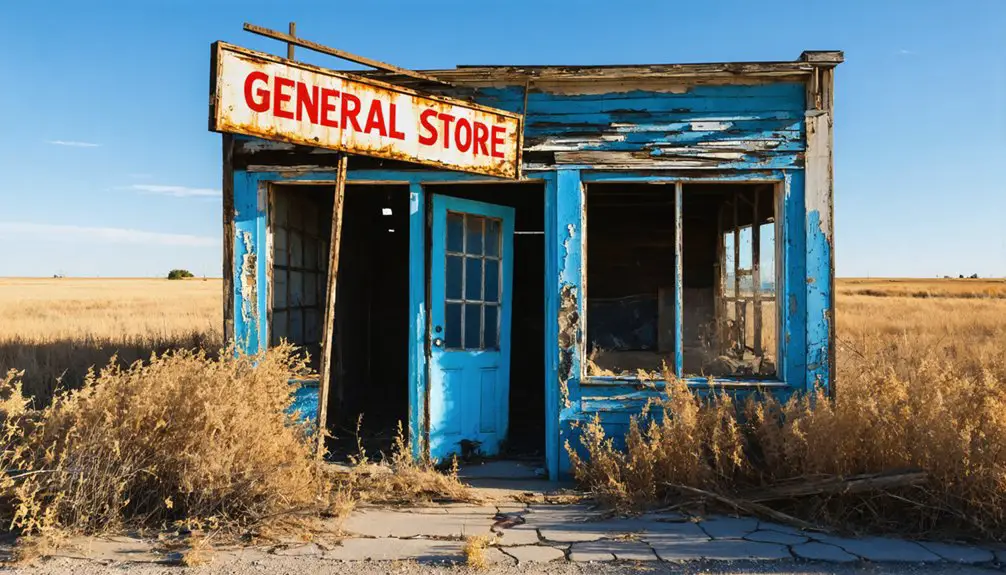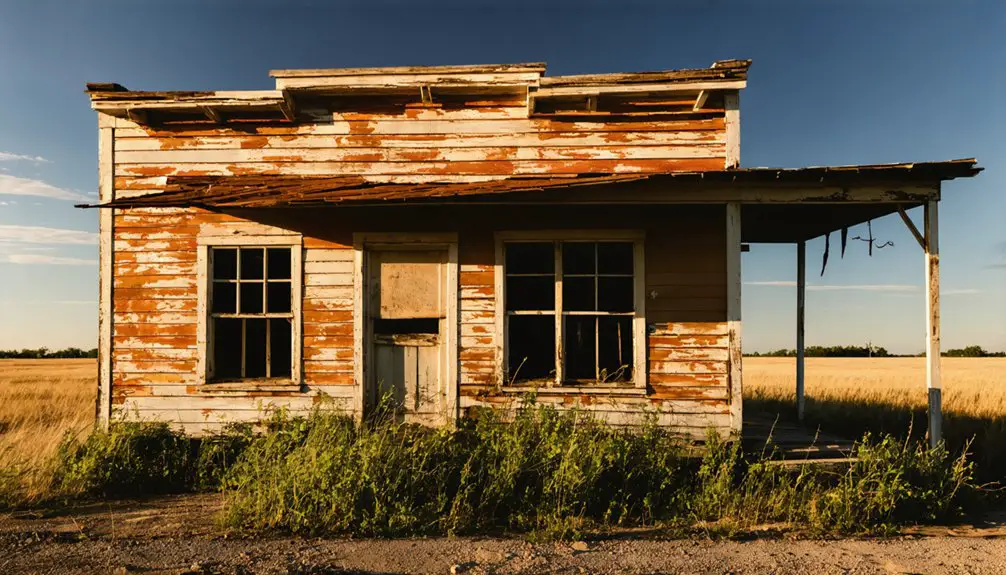You’ll find Eddy in Kay County, Oklahoma, where it first emerged as Osborne before taking its permanent name in 1901. Named after Ed E. Peckham, son of a railroad developer, this once-bustling railroad settlement featured four churches and a vibrant main street. Natural disasters, including devastating fires and tornadoes, combined with shifting economic forces to seal its fate. Beyond its abandoned structures lies a compelling story of Oklahoma’s pioneering spirit and railroad heritage.
Key Takeaways
- Eddy began as Osborne before being renamed in 1901 after Ed E. Peckham, son of a prominent railroad developer.
- The town’s post office operated until 1957, marking its gradual transition into a ghost town status.
- Natural disasters, including devastating fires and tornadoes, contributed significantly to the town’s eventual abandonment.
- The community once thrived with four churches and local stores before economic changes and population shifts led to decline.
- Major highways bypassed Eddy, redirecting commerce and contributing to its transformation into an Oklahoma ghost town.
Origins and Early Development
While many Oklahoma towns sprang up during the railroad expansion of the late 19th century, Eddy’s story began as a settlement called Osborne before taking its permanent name in 1901.
Like countless frontier towns across Oklahoma Territory, Eddy emerged from its roots as Osborne during the great railway boom.
You’ll find the town’s origins deeply intertwined with railroad development in Kay County, as land promotion efforts drew settlers to this promising location.
The town got its new name from Ed E. Peckham, son of railroad developer E.L. Peckham, marking its identity as a growing railroad community.
As typical of Oklahoma settlements at the time, town promoters laid out lots and established essential services.
Similar to Navajoe’s early development in 1887, the town organizers created an eighty-acre town site to accommodate future growth and settlement.
The town followed the pattern of many mining boomtowns that emerged across Oklahoma during this period of rapid development.
The community’s official recognition came with a post office, which would serve the area’s residents until 1957.
Located seven miles southwest of Blackwell, Eddy emerged as a strategic point for trade and transit in north-central Oklahoma.
The Story Behind the Name
When railroads began reshaping Oklahoma’s landscape in the early 1900s, the small settlement of Osborne underwent a significant transformation – including a new name.
On January 3, 1901, you’d have witnessed the town’s rechristening as “Eddy,” honoring Ed E. Peckham, son of influential railroad developer E.L. Peckham. This naming convention wasn’t unusual for the era, as railroad companies often left their mark on communities through such dedications.
The Peckham family’s influence extended beyond Eddy, with E.L.’s own name gracing the nearby town of Peckham. Like many surnames of English origin, the name Eddy would become part of the region’s lasting heritage.
The railroad’s impact on the region shaped not just the physical landscape but the very identity of these frontier communities. Similar to many towns along Route 66’s path, Eddy experienced both prosperous times and eventual decline.
While Eddy’s post office closed in 1957, the name endures as a memorial to Oklahoma’s railroad heritage.
Natural Disasters and Town Destruction
You’ll find that nature dealt devastating blows to early Eddy, where fires repeatedly ravaged homes and businesses throughout the settlement’s history.
The town’s struggles intensified as powerful tornadoes tore through the region, destroying what residents had managed to rebuild after the fires. Just as Pitcher faced tornadoes that destroyed over 150 homes before its final decline, Eddy suffered similar destructive storms. Like Picher’s peak population of 20,000 residents, Eddy once thrived before natural calamities struck.
These relentless natural disasters eventually overwhelmed the community’s resilience, leaving behind abandoned properties that would mark Eddy’s transformation into a ghost town.
Fire Devastates Early Town
As destructive fires swept through early Oklahoma towns, Eddy’s wooden buildings and narrow streets proved particularly vulnerable to the flames that would ultimately contribute to its downfall.
Like many frontier settlements, you’ll find that fire outbreaks accelerated town decline as the community struggled without proper firefighting resources or infrastructure. Similar to other tales in Ghost-Town Tales, these stories of devastation reveal Oklahoma’s challenging frontier history. The town’s fate was sealed when devastating tornadoes struck the already weakened community.
- Blazes spread rapidly through wooden structures packed tightly along the town’s main thoroughfare.
- Limited water access and primitive firefighting methods left buildings defenseless.
- Dry Oklahoma winds fanned flames from building to building, destroying essential businesses.
- Communication delays meant help arrived too late to save critical structures.
The fires that ravaged Eddy were more than just isolated incidents – they represented the beginning of an exodus that would transform this once-bustling community into the quiet ghost town you’d discover today.
Tornadoes Seal Town’s Fate
Once tornadoes began tearing through Eddy’s fragile streets, the town’s fate was sealed.
You’d have witnessed nature’s raw power as F4 twisters ripped steel towers from their concrete foundations and scattered debris across miles of farmland. The EPA Superfund site required extensive cleanup efforts after the storms disturbed toxic mining waste. The tornado aftermath left Eddy’s homes and businesses in ruins, with essential infrastructure shattered beyond repair.
Despite the community’s resilience, the devastating cycle of tornadoes proved too much to overcome. These violent storms killed dozens, injured hundreds, and decimated critical services throughout the region. Chief T. Speck Plunkett observed that Keefeton was gone, leaving only devastation in its wake.
Power lines lay twisted in heaps, while churches and schools – the very heart of small-town life – crumbled into piles of brick and timber. With each passing storm, more residents abandoned their dreams of rebuilding, seeking safer ground elsewhere until Eddy finally faded into memory.
Community Life and Infrastructure
You’ll find few records of Eddy’s humble community life, though a small post office operated intermittently during the town’s brief existence.
A single wooden church once stood among scattered homes and farmsteads, serving as both a place of worship and social gathering spot for local families.
The town’s commercial footprint remained modest, with only basic provisions available at a general store that, like most structures, succumbed to the town’s eventual destruction.
Post Office Operations Timeline
The frontier settlement of Eddy followed a familiar pattern in territorial Oklahoma, where securing a post office meant official recognition and fundamental communication links.
Like nearby Navajoe, which established its post office in 1887, Eddy’s postal operations reflected the community’s connection to the wider world and its emergence as a recognized settlement.
- You’ll find post offices were among the first official buildings in frontier towns, serving as significant hubs for trade and information.
- Local pioneers like W.H. Acers and H.P. Dale fought to establish these outposts, knowing they’d bring legitimacy to their settlements.
- Post office closures often spelled doom for struggling communities, cutting off essential communication lifelines.
- The establishment and closure dates of these postal stations tell the story of a town’s rise and eventual transformation into a ghost town.
Churches and Local Stores
During its peak years in the late 1800s, Eddy boasted a vibrant community life centered around four churches and several local stores, creating a tight-knit social fabric typical of Oklahoma frontier towns.
You’d find these churches serving multiple roles – they weren’t just places of worship, but also hosted schools, town meetings, and social gatherings that kept the community connected.
The local stores went beyond basic commerce, becoming informal meeting spots where you could catch up on news while purchasing essentials.
When fire ravaged the town in the early 1900s, the community’s resilience showed as they rebuilt both churches and stores, understanding their crucial role in maintaining town life.
These structures remained central to Eddy’s identity until a devastating tornado ultimately led to the town’s abandonment.
From Bustling Town to Abandonment

Once bustling with agricultural trade and railroad activity, Eddy transformed from a thriving Kay County community into a stark reminder of Oklahoma’s abandoned past.
Economic changes and population shifts dramatically altered the town’s destiny, as natural disasters and changing transportation routes sealed its fate.
- Multiple devastating tornadoes tore through the community, destroying essential infrastructure and shattering residents’ resolve to rebuild.
- The bypassing of major highways redirected commerce away from Eddy’s once-prosperous business district.
- Local stores and churches closed their doors as population dwindled, marking the end of community gathering spaces.
- Repeated fires throughout the town’s history weakened remaining structures, discouraging new settlers from taking root.
You’ll find today’s Eddy eerily quiet, its empty streets telling tales of prosperity turned to dust.
Legacy in Oklahoma’s Ghost Town History
Among Oklahoma’s 2,000 ghost towns, Eddy stands as a symbol of the state’s complex pattern of boom-and-bust development.
Like many of its forgotten counterparts, it tells a story of economic resilience tested by the whims of industry, railroad routes, and changing regulations that shaped the frontier.
You’ll find Eddy’s legacy woven into the broader cultural heritage of Oklahoma ghost towns, where tales of rapid growth and decline mirror the state’s pioneering spirit.
These abandoned places remind you of a time when towns could spring up overnight and vanish just as quickly.
While some ghost towns earned notoriety through lawlessness or environmental challenges, each abandoned settlement, including Eddy, contributes to our understanding of how external forces – from market shifts to legal changes – could seal a community’s fate.
Frequently Asked Questions
What Were the Population Numbers at Eddy’s Peak?
You’ll find Eddy’s historical population numbers weren’t officially documented, but based on similar Kay County ghost towns’ demographics, it likely peaked at 200-500 residents during its most prosperous period.
Are There Any Remaining Structures or Ruins Visible Today?
Like 90% of Oklahoma ghost towns, you’ll find few visible remains at this site. There aren’t any confirmed standing buildings – just scattered historical remnants like foundations beneath the prairie grass.
What Businesses and Industries Operated in Eddy Besides the Post Office?
You’d have found blacksmith shops serving local agriculture, general stores, and later a thriving metal fencing industry. The railroad’s impact brought freight services, while farmers and ranchers drove early commerce.
Did Any Famous or Notable People Come From Eddy?
You won’t find any famous residents or notable events connected to this small prairie settlement. Historical records don’t mention any prominent individuals emerging from Eddy’s windswept streets before it faded away.
Were There Any Schools or Educational Facilities in Eddy?
While 90% of Oklahoma ghost towns had one-room schoolhouses, you won’t find definitive records of schools in Eddy. Local educational history suggests children likely attended nearby rural schools serving multiple small communities.
References
- https://digging-history.com/2014/09/24/ghost-town-wednesday-navajoe-oklahoma/
- https://www.youtube.com/watch?v=5d-wHDTIbb0
- https://www.okhistory.org/publications/enc/entry?entry=GH002
- https://en.wikipedia.org/wiki/Eddy
- https://www.ghosttowns.com/states/ok/eddy.html
- https://en.wikipedia.org/wiki/List_of_ghost_towns_in_Oklahoma
- https://www.youtube.com/watch?v=dAz-Wx_DWqs
- https://usghostadventures.com/haunted-stories/the-conjuring-house-the-true-story-rarely-told/
- https://mix941kmxj.com/here-is-the-sad-tragic-story-of-toxic-little-oklahoma-ghost-town/
- https://kids.kiddle.co/List_of_ghost_towns_in_Oklahoma



